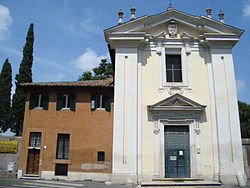- Church of Domine Quo Vadis
-
Church of St Mary in Palmis
Chiesa di Santa Maria delle Piante (Italian)
Sanctae Mariae in Palmis (Latin)Basic information Location Via Appia Antica, 51
Rome, ItalyGeographic coordinates 41°51′59.4″N 12°30′13.4″E / 41.8665°N 12.503722°ECoordinates: 41°51′59.4″N 12°30′13.4″E / 41.8665°N 12.503722°E Affiliation Roman Catholic Ecclesiastical or organizational status Parish church Leadership Fr. Marian Babula, C.S.M.A. Website vicariatusurbis.org Architectural description Architectural type Church Direction of façade Southwest Completed 1637 Specifications Length 17 meters (56 ft) Width 11 meters (36 ft) The Church of St Mary in Palmis (Italian: Chiesa di Santa Maria delle Piante, Latin: Sanctae Maria in Palmis), better known as Chiesa del Domine Quo Vadis, is a small church southeast of Rome, central Italy. It is located about some 800 m from Porta San Sebastiano, where the Via Ardeatina branches off the Appian Way, on the site where, according to the legend, Saint Peter met Jesus while the former was fleeing persecution in Rome. According to the apocryphal Acts of Peter, Peter asked Jesus, "Lord, where are you going?" (Latin: Domine, quo vadis?). Jesus answered, "I am going to Rome to be crucified again" (Latin: Eo Romam iterum crucifigi).
History
There has been a sanctuary on the spot since the ninth century, but the current church is from 1637. The current façade was added in the 17th century.
It has been supposed that the sanctuary might have been even more ancient, perhaps a Christian adaption of some already existing temple: the church is in fact located just in front of the sacred campus dedicated to Rediculus, the Roman "God of the Return". This campus hosted a sanctuary for the cult of the deity that received devotion by travellers before their departure, especially by those who were going to face long and dangerous journeys to far places like Egypt, Greece or the East. Those travellers who returned also stopped to thank the god for the happy outcome of their journey.
The presence of the Apostle Peter in this area, where he is supposed to have lived, appears to be confirmed in an epigraph in the Catacombs of Saint Sebastian that reads Domus Petri (English: House of Peter). An epigram by Pope Damasus I (366–384) in honor of Peter and Paul reads: "You that are looking for the names of Peter and Paul, you must know that the saints have lived here."
The two footprints on a marble slab at the center of the church — nowadays a copy of the original, which is kept in the nearby Basilica of San Sebastiano fuori le mura — are popularly held to be a miraculous sign left by Jesus. It is to these footprints that the official name of the church alludes: palmis refers to the soles of Jesus' feet. It is likely that these footprints are actually the draft of an ancient Roman "ex voto", a tribute paid to the gods for the good outcome of a journey.[citation needed]
There was an inscription above the front door on the church's façade which used to say: "Stop your walking, traveller, and enter this sacred temple in which you will find the footprint of our Lord Jesus Christ when He met with St. Peter who escaped from the prison. An alms for the wax and the oil is recommended in order to free some spirits from Purgatory." Pope Gregory XVI found the advertising tone of this inscription so inappropriate that he ordered its removal in 1845.[citation needed]
The church is currently administered by priests of the Congregation of Saint Michael the Archangel.
See also
External links
Categories:- Roman Catholic churches in Rome
- Relics associated with Jesus
- Roman Catholic congregations established in the 17th century
- Buildings and structures completed in 1637
Wikimedia Foundation. 2010.


